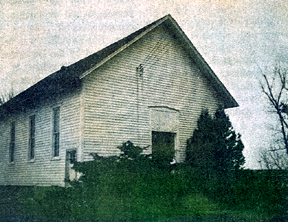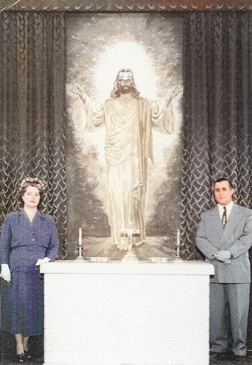|
|
|
The sign on the lawn said that this
Church was built in 1889. However, the Webster Congregation was older
than that. There are no early records, but it could be many years
older, for this congregation was meeting and having services at the
Drake School house for an unknown number of years. Ministers of
various denominations conducted services and served as pastors. The
two leading groups seem to have been Campbellites and
Methodists.
The original name of the church was Webster Methodist Church. When the town of Webster became large enough to warrant a Post Office, the town name was changed to Middle River because there was already another Webster, Iowa Post Office. |
Webster Methodist Church |
||||
|
Correspondingly, the name of the church was renamed the Middle River Methodist Church and remained so until the Middle River Post Office was closed at which time it reverted back to Webster Methodist Church. The carpenter who built the Church was Max Hockenberry. Some of the men who assisted: Shaw Binns, John Sawyers, Abraham Dennis Drake and Harry Falkner DeVault (grandfathers of Cecil & Loretta Drake.), Ellis Crawford, and Joseph Crawford. Joseph Crawford was a Quaker from Pennsylvania and never joined the Methodist Church, but Mrs. Crawford was a member. Jake Crow, also a carpenter, helped. The lumber for building the new church was hauled by wagon and teams from Winterset. Originally the church had a belfry and a bell. I wish it were still there. Why it was removed many of you know. The carpenter who built the Church was Max Hockenberry. As told to me by people now living, but recalled from parent or grandparents or other acquaintances, these are some of the men who assisted: Shaw Binns, John Sawyers, Abraham Dennis Drake and Harry Falkner DeVault (grandfathers of Cecil & Loretta Drake.), Ellis Crawford, and Joseph Crawford. Joseph Crawford was a Quaker from Pennsylvania and never joined the Methodist Church, but Mrs. Crawford was a member. Jake Crow, also a carpenter, helped. There were no doubts many others. Dedication services were conducted by Rev. H. D. Preston. The first Sunday School Superintendent was Charles Gaymon. Average attendance was 100. A Ladies Aid was organized before 1912. Some early officers were Mrs. Fox, Mrs. Bingaman and Mrs. Donna Ramsey. The Sydney Morris’s recall three ministers who served the charge prior to 1914. There were Reverends Smith, Clearwater, and Williams. These early ministers often participated in public gatherings as a means of communication other than from pulpit to pew. Nina Drake and Carrie Hart were married by Rev. Clearwater on December 1, 1909. Rev. Smith drove from Winterset and Mrs. Morris recalls that Nona Crow stayed with this family while in high school. The record shows Rev. Perkins pastor of Webster for one year 1914.
Rev. Pruitt became the next pastor in 1915. During Rev. Pruitt’s pastorate, a camp meeting was held. The huge tent was located southwest and next to the Church. People gathered from many miles distant to attend the meeting and many converts professed their faith. The meeting was conducted by an Evangelist. Rev. Pruitt followed the camp meeting later with a baptismal service at Middle River. Pearl Morris, Angie (Estel) Beaman, Amy Estel, and Bernice Ramsey were among those baptized. At this time, the baptism was held at the river so that those desiring immersion could have the rite in which they believed.
Rev. Griggsby followed in 1916. Rev. Barnes, 1917, lived at West Star, and at this time Webster and West Star were his charge. Sydney Morris followed in 1919-1920. Some members were Ora & Nina Hart, Fred & Nona Eyerly, Merton & Pearl Cline, Vera Nelson, Charles & Carrie DeVault, the Frank Fox family, John & Elizabeth Estel, Goldie & Ellis Estel, Shaw Binns, wife Emily and son Ray, and Ellis Crawford. Mr. Frank Busch, who though a staunch Campbellite, came here for church and was a class teacher in the Sunday School. Some of the choir members were Mabel Nelson (organist), Orville Nelson, John Drake, Ira Crow, Mata Gaymon, Jimmie Gertie Binns, Verdi Howard Craven and Gertie Howard Fox. Orie and Nina Hart, and Bert and Emma Holland.
Rev. Weed followed in 1922 and served as pastor of this Church for 9 years. Rev. Rower became pastor 1931-1933. Rev. E. J. Zunsteg was pastor in ’36. Ora and Zola Lowden joined this Church during Rev. Zunsteg's pastorate, and Zola was superintendent during part of this period. In 1939-1941, Rev. Reep, a young college student, quiet and reserved was pastor. On September 1, 1940 the Ladies Aid was reorganized into the Women’s Society of Christian Service. This organization was instrumental in advocating for adding a basement to the church building.
About fourteen years later, during the pastorate of Don Cutler, Hazelle Crawford was contacted by Mrs. Cooper, wife of Dr. Cooper, Creston District Superintendent, for service as a district officer. For the next nine years, Hazelle served at the district level. Her first four years were served as promotion secretary and president for two years. At this time, Webster Church was transferred from the Creston District to the Des Moines District. Soon after this transfer, Hazelle was asked to be treasurer of the Des Moines District W.S.C.S. After two years, she became the president where she served for three years before retiring.
|
|||||
|
This Church is of the Webster Community.
An altar was built, carpet was laid, and in 1954 the lovely painting
(seen at right), which has added so much to the mood and Sacredness
of our services, was presented by Madge Stever on an Easter Sunday,
during Don Cutler’s pastorate. On that Sunrise Service, Easter
morning, the sun shone through the eastern window of our
church to light the altar.
Following Rev. Reep was Rev. Hartin 1942-43, a product of West Virginia coal mines. Rev. Hartin was followed by Rev. Crouse, who came to the charge in July of 1946. In 1947 Doris Egger, Bill Eckles, Joan Crawford and Laura Mae Crawford were admitted to membership. Rev. Ben Hamilton became pastor in 1948. His son Leo, a teenager, was considering the ministry and conducted the Webster nine o’clock service the last few months of Rev. Hamilton’s pastorate. In 1948 John Hart, Annette Stever, Loretta Stever and Alice Roberts became church member as did Lois Hart in 1949. |
Madge Stever & Pastor Don Cutler at New Altar and Paining of Christ |
||||
|
The church survived another twenty years, it's final service being January 9, 1972. Pastors assigned to the church during that period included Revs. Knight, Earl Streyfeller, Don Enright, Kelly, Lint, Milton Haedt, and Ward Young. New members included Gary Beaman, Mr. & Mrs. Delbert Dolson & daughter Doris, Richard Hart, Shirley Hart, John and Wilma Holtmyer and sons Darwin and Lee, Ludwig and Della Horn, Billy Martin, Karen Martin, Janice Steve, Steve Stever and Betty and Shirley Sillbaugh, Wayne and Mary Griffith. ___________________
|
|||||
| Maintained by the County Coordinator |
This
page was created on December 10, 2010. This page was last updated Thursday, 02-Feb-2023 17:48:21 CST . |




